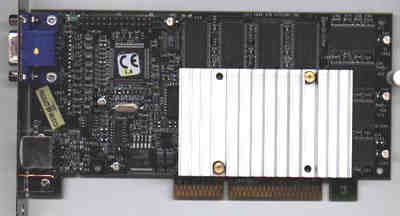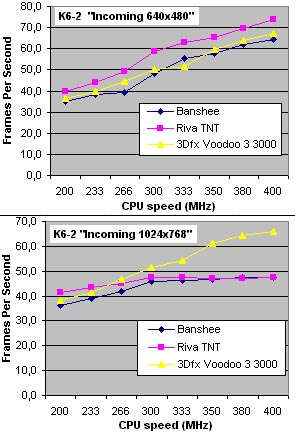|
|
|
3dfx Voodoo 3
3000
April
9, 1999
by
Eric van Ballegoie
3Dfx is back in the arena with a new
look. Not only did they change their logo, but they also changed
their name from 3Dfx to 3dfx, loosing the capitalized "D". But all
that is just the outside, the inside of 3dfx has undergone some more
serious changes. In the fourth quarter of 1998 3dfx merged with
graphics board company STB. By doing so 3dfx became a all-in-one
company holding the entire production line from the chip design
right down to the design of the retail boxes. By acquiring STB, 3dfx
said goodbye to major OEM's like Diamond and Creative who will not
get any Voodoo 3 chips to make boards with. STB will be the sole
supplier of Voodoo 3 products.

All Voodoo 3 boards made by STB will be
sold under the name 3dfx, hence we won't see "STB" on the retail
boxes. There will be three major flavors of Voodoo 3 cards, the
Voodoo 3 2000, the 3000 and the 3500. The main difference is the
speed at which the cards will run. Unlike many other chipsets out
there, the Voodoo 3 chipset runs both core and memory at the same
clockspeed, avoiding timing problems. The Voodoo 3 2000 will run at
a clockspeed of 143 MHz, the 3000 does its work at 166 MHz, and the
3500 is shaking it at no less than 183 MHz. As you can imagine this
requires top of the line SDRAM, as 183 MHz requires parts rated at 4
nano seconds (FYI: PC100 SDRAM in normal PC's is rated 8 ns). This
is probably the main reason why 3dfx is still holding back the 3500
version of the Voodoo 3 chipset. I was given a 3000 sample which is
equipped with SDRAM rated at 6 ns, running 166 MHz.
When we take a look under the hood of
Voodoo 3 we don't see really stunning new features. Basically what
3dfx did was pack the best of both worlds into a single chip. The
base 2D core of the Banshee chipset is found back in the Voodoo 3,
and the 3D part is pretty much equivalent to a Voodoo II SLI, at
least performance wise. Unfortunately 3dfx didn't care to support 32
bits rendering claiming that it costs too much performance. But with
a chipset that can crunch polygons at this speed, I would have liked
to be able to choose for the slower gameplay in return for the
superior image quality. A hangover from the Banshee chipset is the
memory limit which is set at 16 MB. Together with the lack of AGP
Direct Memory Execution support, this gets one wondering about the
performance in games with large textures... Only time will tell if
this is really a problem.
One of the most interesting features is
the 350 MHz RAMDAC which enables 75 Hz at 2046x1536. Not that you
will find any CRT monitor that can cope with that kind of force, but
it's cool anyway.The Voodoo 3 chipset has a dual pixel pipeline
which enables it to process two pixels per clockcycle, leading to
the following performance specs:
- 8 million triangles per second (Voodoo3 3500 at 183
MHz)
- 7 million triangles per second (Voodoo3 3000 at 166
MHz)
- 6 million triangles per second (Voodoo3 2000 at 143
MHz)
- 366 megatexels per second fill rate (Voodoo3 3500 at
183 MHz)
- 333 megatexels per second fill rate (Voodoo3 3000 at
166 MHz)
- 286 megatexels per second fill rate (Voodoo3 2000 at
143 MHz)
- 100 billion operations per second
(Voodoo3 3500 at 183 MHz)
So what does all that mean in real life?
Well, earlier this year Tony Tamasi told me that the performance we
could expect form Voodoo 3 would be about the same as Voodoo II SLI.
Let's have a look at what I got on my good old Pentium II 400 / 128
MB / Soyo SY6BA / Win 98 / Dx61
: |
| |
3dfx Voodoo 3
3000 |
Diamond Monster II
SLI |
Diamond Monster
II |
Hercules Dynamite
TNT |
Guillemot MG Phoenix
AGP |
|
Cooling |
Heatsink |
none |
active |
active |
heatsink |
|
Bus Type |
AGP |
PCI |
PCI |
AGP |
AGP |
|
Chipset |
3dfx Voodoo 3 3000 |
3Dfx Voodoo II |
3Dfx Voodoo II |
nVidia Riva TNT |
3Dfx Banshee |
|
Ram Type |
6 ns SDRAM |
25 ns EDO |
25 ns EDO |
8 ns SDRAM |
8 ns SGRAM |
|
Ram
Amount |
16 Mb |
24 Mb |
12 Mb |
16 Mb |
16 Mb |
|
Price |
$ 178
US |
$ 250 US |
$ 125 US |
$ 130 US |
$ 110 US |
|
3D
Benchmarks |
|
Quake II
640 |
108 |
101,9 |
90,5 |
80,9 |
68,4 |
|
Quake II
800 |
103,4 |
97,8 |
69,1 |
65,3 |
47,9 |
|
Quake II
1024 |
81 |
75,9 |
x |
42,6 |
27,8 |
|
Turok 640 |
(* 182,9 / 125,6 |
(* 188.0 / 136.1 |
(* 99.7 / 101.0 |
127,5 |
(* 123.3 / 109.7 |
|
Turok 800 |
111 |
118 |
65,4 |
93,6 |
79,8 |
|
Incoming
640 |
105,5 |
103,4 |
87,3 |
104,5 |
91,8 |
|
Incoming
800 |
101,5 |
102,3 |
61 |
77,9 |
68,6 |
|
Incoming
1024 |
74.7 |
76,6 |
x |
48,5 |
44,1 |
|
Forsaken
640 |
160,4 |
163,4 |
139,4 |
153,5 |
156,3 |
|
Forsaken
800 |
154,5 |
160,8 |
99,6 |
124,6 |
124,6 |
|
Forsaken
1024 |
119,7 |
122,1 |
x |
75,3 |
78 |
|
2D
Benchmarks |
|
BapCo Corel
8 |
171 |
x |
x |
170 |
182 |
|
BapCo Excel
97 |
158 |
x |
x |
158 |
171 |
|
BapCo
Netscape
4.01 |
157 |
x |
x |
150 |
171 |
|
BapCo
Photoshop |
161 |
x |
x |
158 |
173 |
|
BapCo
PowerPoint
97 |
169 |
x |
x |
170 |
184 |
|
BapCo Word
97 |
190 |
x |
x |
193 |
209 |
|
As you see the performance is about the
same as that of a Voodoo II SLI setup. The main advantage which the
Voodoo 3 has over Voodoo II SLI is the increased resolution. Voodoo
II SLI tops out at 1024x 768 (or 1024x1024 with certain drivers),
while Voodoo II goes up as high as 1600x1200 in 3D
modes...
K6-2 performance is also quite
interesting. In 640x480 the card is usually outperformed by TNT
cards. When we move to 1024x768, the difference is the other way
around. The graphs below were initially meant to be included in my CPU scaling article, but now I'll publish
it here:

When I opened up the packaging of the
Voodoo 3 card I was stunned by the enormous heatsink which covers
the Voodoo 3 chip. It's a heatsink-only solution, meaning that it
doesn't have a built-in fan or anything. This way the size of the
heatsink is definitely needed. When you run Quake II for about half
an hour, it reaches a temperature of 55 deg C, and that's on a bare
mainboard which isn't built inside a computer case... I personally
think an active cooler would have been a better option.
Even though there's always something we can complain
about, I have to give it to 3dfx for getting on stage with the
fastest 2D/3D card to date. The incredible fill-rate guarantees top
performance even in very high resolutions. The performance is about
the same as that of a Voodoo II SLI combo, which has been the top
performance solution for about a year now. Until S3, Matrox,
Videologic and nVidia will come out with their new products, 3dfx
holds the top spot. And even then we have to see if any of them can
get past Voodoo 3...... A definite recommendation for anyone looking
for the best 2D and 3D.

3dfx Voodoo 3
3000
suggested retail price Voodoo3 2000 is
$129.99
suggested retail price Voodoo3 3000 is
$179.99
suggested retail price Voodoo3 3500 is
$249.99.
HOME: More Reviews
All rights reserved.
©
1997/ 1999 Eric van
Ballegoie.
Owner /
Webmaster. | |